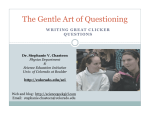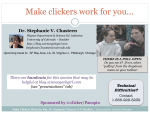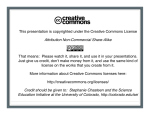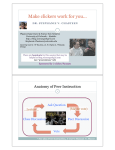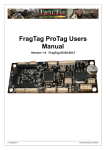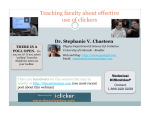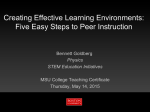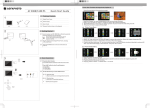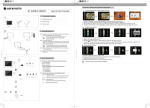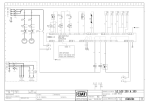Download Facilitating-clicker.. - University of Colorado Boulder
Transcript
Gallery Walk • While you are coming in, browse the example questions on the wall • What would an instructor be trying to accomplish with this question? Aihofanz2010 on Wikimedia Facilitating Clickers Effectively Dr. Stephanie V. Chasteen (Physics) Dr. Jenny Knight (MCDB) Science Education Initiative University of Colorado – Boulder http://STEMclickers.colorado.edu [email protected] Agenda: Part 1: The Why and How Part 2: Facilitation Matters Creative Commons – Attribution. Please attribute Stephanie Chasteen / Scince Education Initiative/ CU-Boulder This presentation is copyrighted under the Creative Commons License" Attribution Non-Commercial Share-Alike! " " That means: Please watch it, share it, and use it in your presentations. Just give us credit, don’t make money from it, and use the same kind of license on the works that you create from it." More information about Creative Commons licenses here: http://creativecommons.org/licenses/" Credit should be given to: Stephanie Chasteen and the Science Education Initiative at the University of Colorado, ! http://colorado.edu/sei! • " Part 1: The Why and How U. Colorado clicker resources… Videos of effective use of clickers http://STEMvideos.colorado.edu 2-5 mins long Clicker resource page http://STEMclickers.colorado.edu • Instructor’s Guide • Question banks • Workshops • Literature / Articles 5 Creative Commons – Attribution. Please attribute Stephanie Chasteen / Science Education Initiative/ CU-Boulder Warm Up: Why question? 6 • Why do we ask questions? When might we use questions? What is the purpose of clicker questions? Warm up activity Discuss in small groups, making notes in handout. Then share-out. Creative Commons – Attribution. Please attribute Stephanie Chasteen / Science Education Initiative/ CU-Boulder Example question: Biology 7 A small acorn over time can grow into a huge oak tree. The tree can weigh many tons. Where does most of the mass come from as the tree grows? A) Minerals in the soil B) Organic matter in the soil C) Gases in the air D) Sunlight Common misconception leads to answers (A) and (B). Correct answer: C 7 Creative Commons – Attribution. Please attribute Stephanie Chasteen / Science Education Initiative/ CU-Boulder Example question: Astronomy You look to the eastern horizon as the Moon is rising and discover that it is in the new moon phase. Later that same day when the moon is setting, which of the moon phases shown below would the Moon have looked like? Center for Astronomy Education, Ed Prather 8 Example Question: History In your opinion, which had the most posi4ve impact on the modern world? A) coffee B) tea C) chocolate D) spice E) sugar 9 Peter Newbury, UCSD Clickers help students learn... the learning cycle BEFORE DURING AFTER setting up instruction developing knowledge assessing learning Adapted from Cynthia Heiner, Peter 10 Newbury, Rosie Piller, Ian Beatty, Stephanie Chasteen Clickers help students learn... the learning cycle BEFORE DURING AFTER setting up instruction developing knowledge assessing learning Adapted from Cynthia Heiner, Peter 11 Newbury, Rosie Piller, Ian Beatty, Stephanie Chasteen Clickers help students learn... the learning cycle BEFORE DURING AFTER setting up instruction developing knowledge assessing learning Adapted from Cynthia Heiner, Peter 12 Newbury, Rosie Piller, Ian Beatty, Stephanie Chasteen Clickers help students learn... the learning cycle BEFORE DURING AFTER setting up instruction developing knowledge assessing learning Adapted from Cynthia Heiner, Peter 13 Newbury, Rosie Piller, Ian Beatty, Stephanie Chasteen Clickers help students learn (the research) Research shows that: • Students can better answer a similar question after talking to their peers • Students like peer instruction • Peer instruction classes outperform traditional lectures on a common test • Peer discussion + instructor explanation of question works better than either one alone See http://STEMclickers.colorado.edu for various references Clickers help teachers teach... BEFORE DURING AFTER setting up instruction developing knowledge assessing learning Adapted from Cynthia Heiner, Peter 15 Newbury, Rosie Piller, Ian Beatty, Stephanie Chasteen Clickers help teachers teach... Are they ready for the next topic? What do they already know? Do they care about this? What DO they care about, anyway? BEFORE DURING AFTER setting up instruction developing knowledge assessing learning Adapted from Cynthia Heiner, Peter 16 Newbury, Rosie Piller, Ian Beatty, Stephanie Chasteen Clickers help teachers teach... Where are they in the activity? Are they getting it? Do I need to intervene? Did they notice key idea X? BEFORE DURING AFTER setting up instruction developing knowledge assessing learning Adapted from Cynthia Heiner, Peter 17 Newbury, Rosie Piller, Ian Beatty, Stephanie Chasteen Clickers help teachers teach... Did they get it? Can I move to the next topic? Did that activity work? How did I do? BEFORE DURING AFTER setting up instruction developing knowledge assessing learning Adapted from Cynthia Heiner, Peter 18 Newbury, Rosie Piller, Ian Beatty, Stephanie Chasteen Clickers are a tool for questioning But not a magic bullet! Don’t equate the pedagogy with the technology. So what IS the pedagogy? 19 Anatomy of a Clicker Question: Peer Instruction Anatomy of a clicker question Ask Question …Lecture… Debrief / Class Discussion (May vote individually) Peer Discussion Vote * See also: Peer Instruction, A User’s Manual. E. Mazur. 21 Let’s try it… Which superpower would you rather have? The ability to… A. Change the mass of things B. Change the charge of things C. Change the magnetization of things D. Change the boiling point of things 22 Question: Ian Beatty, UMass-Amherst Image: Thibault fr on Wikimedia Question break Ask Question …Lecture… (May vote individually Peer Discussion Debrief Vote Creative Commons – Attribution. Please attribute Stephanie Chasteen / Science 23 Education Initiative/ CU-Boulder 5 Minute Break • Stretch your legs and look at the example questions on the wall • What would an instructor be trying to accomplish with this question? How would you use it? Part 2 Facilitation Matters Remember, not a magic bullet! Or, “the perfect question doesn’t solve all problems” Implementation is also important. 26 Clicker Choreography See handouts for more details about the process of running a clicker question and common pitfalls. Will you modify this approach? Honestly, I think that I’m most likely to modify this technique of peer instruction to suit me and my students. I know that there are at least ___ parts of the technique that I’ll be changing: A. None B. One C. Two-three D. Four or more Is there a problem with modifications? Probably. You’re smart & you care about teaching. Be strategic about modifications. Reacting to their Votes After the (first or second) vote… Don’t show the histogram to the class (yet): • Popular choices may sway second vote. • a student who picked an unpopular choice may be reluctant to participate in discussions You can motivate students without showing the histogram, e.g., by saying “there seem to be two popular answers” Reacting to their votes You don’t know what’s going to happen but you can an#cipate and prepare yourself for the likely outcomes. When you know the first-vote distribution (but they don’t) you have lots of options. This is where you show your “agility.” 31 First Vote #1 What do you think you should do with this first-‐vote distribu4on? (C is the correct answer) A) “Turn to your neighbours and convince them you’re right” B) move on – everyone got it C) confirm correct answer and move on D) “Can someone who answered C tell us why they made that choice?” E) other 32 First vote #2 What do you think you should do with this first-‐vote distribu4on? A) “Turn to your neighbours and convince them you’re right” B) confirm correct answer and move on C) “Can someone who answered B tell us why they made that choice?” D) “Would someone like to explain why they picked the answer they did?” E) other 33 First Vote #3 What do you think you should do with this first-‐vote distribu4on? A) “Turn to your neighbours and convince them you’re right” B) confirm correct answer and move on C) “Can someone who answered B tell us why they made that choice?” (etc.) D) “Would someone like to explain why they picked the answer they did?” E) other 34 First Vote #4 What do you think you should do with this first-‐vote distribu4on? (C is not the correct answer) A B C D E 35 Second Vote What do you think you should do if this is the second-‐vote distribu4on? 36 What are the challenges? What do you think is / will be the toughest thing about using Peer Instruction? Brainstorm with neighbor(s) for just a few minutes. Creative Commons – Attribution. Please attribute Stephanie Chasteen / Science Education Initiative/ CU-Boulder What are the challenges? What do you think is / will be the toughest thing about using Peer Instruction? A. Writing good questions B. Technical issues C. Tough to get students to discuss questions D. I have too much content to cover / takes too much time E. Something else Creative Commons – Attribution. Please attribute Stephanie Chasteen / Science Education Initiative/ CU-Boulder Practices to avoid common challenges: Challenge Possible solution Content coverage? 1. Focus questions on key concepts. 2. Reduce content in class or course. Students reluctant to discuss? 1. 2. 3. 4. 5. 6. Students reluctant to share with class? 1. Circulate and eavesdrop 2. Give incentives (candy?) 3. Create a safe environment Make it clear why you’re doing this Use interesting questions Circulate during question Focus on reasoning in wrap-up Ask for student reasoning in wrap-up Careful about motivating w/ points (can backfire) Student buy-in is key! Option 1: Explain why you are doing this Option 2: Demonstrate why you are doing this Action Plan • Take a few minutes to write down your action plan to implement ideas you heard about in the workshop • Please also fill out the FTEP evaluation form. We value your feedback! Thank you! Clicker choreography These are in your handouts 1. Present the question. Don’t read it aloud. Reasons for not reading the question aloud: • your voice may give it away • the students are not listening anyway – your voice may distract them from reading 43 Clicker choreography 2. “Please answer this on your own.” Goals of the first, solo vote: • get the students to commit to a choice • get the students curious about the answer • get the students prepared to have discussion w/ peers If they discuss the question right away: • Some students are making choices based on someone else’s reasoning 44 Clicker choreography 3. Don’t start the i>clicker poll. Instead give the students sufficient time to make a choice. What is sufficient? • Turn to the screen, read and answer the question as if you are one of your students. • Another possibility: keep facing the class, helping those with confused stares. • Another possibility: model how to think about the question by “acting it out.” • When you notice students picking up their clickers and getting restless, they are prepared to vote. 45 Clicker choreography 4. When you have made a choice or when you see the class getting restless, ask the students, “Do you need more time?” If many students are not ready to vote, they will not have committed to a choice and will be unprepared to discuss the question. Some students may be uncomfortable asking for more time. Make it clear, from the first class, that you’ll honour the request with no repercussions to the student who asked. 5. “Yes!” Give them a few more seconds. “[silence]” Ask them to prepare to vote. 46 Clicker choreography 6. “Please vote.” If you’ve given them sufficient time to commit to a choice, the voting should take very little time. Another option: watch the number of votes and when most of the votes are in say, “Can I have your final answers, please?” Don’t wait for every last student to vote. Some may be choosing not to vote. 47 Clicker choreography 7. Check distribution of votes on the i>clicker receiver. Don’t show the histogram to the class (yet): • Popular choices may sway second vote. • a student who picked an unpopular choice may be reluctant to participate in discussions You can motivate students without showing the histogram, e.g., by saying “there seem to be two popular answers” 48 Clicker choreography 8. Depending on the distribution of votes, proceed. We’ll discuss reacting to various distribution scenarios in a few moments. 49 Clicker choreography 9. Have students discuss with peers (usually) Allow enough time (2-5 minutes) Circulate the room to listen / ask questions / model discussion This process is greatly enhanced if students buy-in (more on this later) 50 Clicker choreography 10. At the end, confirm the answer(s) and continue with the class. Even if more than 80–90% of the students have picked the correct choice, some students are still not sure why that choice is correct. Briefly confirm the correct choice: • explain why the correct choice is correct • explain why popular distractors are incorrect • allows those who chose the correct answer to make sure they had the correct reasoning 51



















































